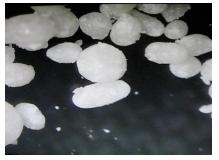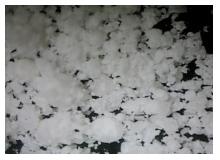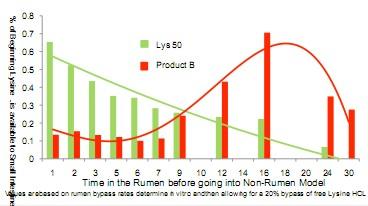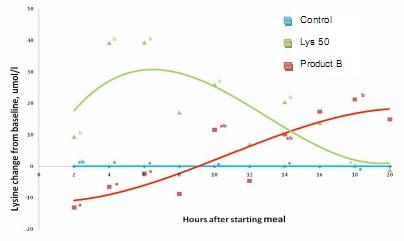Rumen Bypass Lysine for use in Dairy Nutrition
Published: March 30, 2010
By: R. Musser and F. Valdez
Introduction:
Developing and verification of an in vitro methodology is a critical first step for the evaluation of a rumen bypass lysine source. Due to the variation in technologies of rumen bypass lysine, results of the different methods need to be evaluated. Once you have the in vitro method developed, understanding passage rate of product is critical. Most products are screened only using the Sterns 3 step method (Stern, 1995), which was developed for products with longer rumen retention (animal protein sources). The problem with using one method is that it may not accurately demonstrate the passage and release rate of products using fatty acid matrix or other polymer coatings. The in vitro method you use must encompass many time points, so you can understand the impact of rumen passage rate, and the method must also have a procedure for evaluation of measuring gastric and small intestinal release rates. Once an in vitro methodology that can address the above is established, the true rumen passage rate can be determined by multiple time point blood samplings of lactating dairy cows given a single dose of the product.
Materials and Methods:
In vitro methods were based on combinations of rumen degradation and intestinal release information. This methodology of Sapienza Analytica, LLC (Slater, Iowa, US) is based on procedures described by Goering and Van Soest (1970) with some modifications as described by Bossen (2007). This two part assay first measures degradation of rumen bypass lysine every 2 hours for 30 hours, for determination of rumen bypass rate. It is important to measure test material not just dry matter loss for true determination of lysine losses in rumen. In the first study we used two (2) sources of rumen bypass lysine: Lys 50 (Kemin Industries, Des Moines, Iowa) and Product B (US mfg product). The products were 50% and 48% Lysine HCL respectively, with Lysine HCL being 78.6% Lysine.
The in vitro procedure used extracted rumen fluid that was not strained, but used in the condition it was collected. This enables the rumen fluid to be delivered to the incubation vessels within 20 minutes of extraction from each of the donor animals in order to limit the negative effects on ruminal protozoa. A portion of the natural fiber mat was also included to help maintain the integrity of the natural population of fiber degrading microorganisms. This media was then kept under CO² environment with 3 gram samples placed in Dacron bags being randomly assigned to each of the 1 gallon vessels. Testing was done in replicates of four, for each time period and phase. Containers were stirred every three (3) hours, and samples were held below the surface of the liquid. After the designated period of time (depending on sample, 2-30 hrs), samples were removed, washed, and dried at low temp for determination of rumen bypass and degradation rates with the values being average of the replicates.
The second part of this in vitro methodology measures the intestinal release rate of the material that passes the rumen fluid. This involves a second set of samples which had been incubated as described above, then after designated time in rumen fluid, samples were removed, washed, and then incubated in a gastric and intestinal model. This model uses a pH 3 “Gastric” model with pepsin for 3 hours then sample is washed and placed in the “Intestinal” model. The conditions of the “Intestinal” model are 9 hour incubation at pH 8 with pancreatic enzymes and additional lipase enzyme. Once the 3+9 hr periods are concluded, samples are washed, dried, and assayed for nitrogen to determine amount of remaining lysine that is determined to be totally unavailable.
Therefore to determine intestinal availability the calculation is based on the difference of starting material (Figure 1), rumen bypass material (Figure 2), and total unavailable material (Figure 3) with the calculation being: grams of lysine HCL in bag to begin – grams of lysine lost in rumen – grams of material not available = grams intestinally available lysine. The result of the in vitro study is a view of what the intestinally available lysine amount is at differing periods of rumen passage rate. To understand how to interpret the findings for animal nutrition, a study must be done to gather data on what is the true rumen passage rate of the rumen bypass lysine source.
The in vivo study that was used in this series of research used lactating Holstein cows, which were given a single dose of additional Lysine HCL, followed by multiple blood samplings. This study was conducted in the summer of 2009, at South Dakota State University. In a completely randomized design with, six (6) cows per treatment were fed control TMR (Total Mixed Rations, Lys % MP = 6.7) for 6 days prior to administration of treatments on the seventh day. A dose of 150 grams of Lysine HCL was fed on the 7th day at 8:00 am, with jugular plasma samples being taken every 2 hours after feeding for 20 hours. A baseline sample of plasma was also taken 30 minutes prior to feeding.
Treatments consisted of a control, Lys 50, or Product B. Products were fed at 150 grams of Lysine HCL equivalent; with 300 grams of Lys 50 fed and 313 grams of Product B fed. Cows were offered the treatments in mixture of 1 kg ground corn for up to 30 minutes, then allowed to eat control ration for remainder of day.
During the analysis, adjustments were made for increases in plasma lysine level, based on blood sample taken 30 min prior to meal, and the diurnal pattern of lysine for the animals eating only the control TMR. This adjustment allowed for determination of what impact additional rumen bypass lysine had on plasma lysine levels. Statistical method used was Proc Mix using SAS Software.
The in vitro procedure used extracted rumen fluid that was not strained, but used in the condition it was collected. This enables the rumen fluid to be delivered to the incubation vessels within 20 minutes of extraction from each of the donor animals in order to limit the negative effects on ruminal protozoa. A portion of the natural fiber mat was also included to help maintain the integrity of the natural population of fiber degrading microorganisms. This media was then kept under CO² environment with 3 gram samples placed in Dacron bags being randomly assigned to each of the 1 gallon vessels. Testing was done in replicates of four, for each time period and phase. Containers were stirred every three (3) hours, and samples were held below the surface of the liquid. After the designated period of time (depending on sample, 2-30 hrs), samples were removed, washed, and dried at low temp for determination of rumen bypass and degradation rates with the values being average of the replicates.
The second part of this in vitro methodology measures the intestinal release rate of the material that passes the rumen fluid. This involves a second set of samples which had been incubated as described above, then after designated time in rumen fluid, samples were removed, washed, and then incubated in a gastric and intestinal model. This model uses a pH 3 “Gastric” model with pepsin for 3 hours then sample is washed and placed in the “Intestinal” model. The conditions of the “Intestinal” model are 9 hour incubation at pH 8 with pancreatic enzymes and additional lipase enzyme. Once the 3+9 hr periods are concluded, samples are washed, dried, and assayed for nitrogen to determine amount of remaining lysine that is determined to be totally unavailable.
Therefore to determine intestinal availability the calculation is based on the difference of starting material (Figure 1), rumen bypass material (Figure 2), and total unavailable material (Figure 3) with the calculation being: grams of lysine HCL in bag to begin – grams of lysine lost in rumen – grams of material not available = grams intestinally available lysine. The result of the in vitro study is a view of what the intestinally available lysine amount is at differing periods of rumen passage rate. To understand how to interpret the findings for animal nutrition, a study must be done to gather data on what is the true rumen passage rate of the rumen bypass lysine source.
The in vivo study that was used in this series of research used lactating Holstein cows, which were given a single dose of additional Lysine HCL, followed by multiple blood samplings. This study was conducted in the summer of 2009, at South Dakota State University. In a completely randomized design with, six (6) cows per treatment were fed control TMR (Total Mixed Rations, Lys % MP = 6.7) for 6 days prior to administration of treatments on the seventh day. A dose of 150 grams of Lysine HCL was fed on the 7th day at 8:00 am, with jugular plasma samples being taken every 2 hours after feeding for 20 hours. A baseline sample of plasma was also taken 30 minutes prior to feeding.
Treatments consisted of a control, Lys 50, or Product B. Products were fed at 150 grams of Lysine HCL equivalent; with 300 grams of Lys 50 fed and 313 grams of Product B fed. Cows were offered the treatments in mixture of 1 kg ground corn for up to 30 minutes, then allowed to eat control ration for remainder of day.
During the analysis, adjustments were made for increases in plasma lysine level, based on blood sample taken 30 min prior to meal, and the diurnal pattern of lysine for the animals eating only the control TMR. This adjustment allowed for determination of what impact additional rumen bypass lysine had on plasma lysine levels. Statistical method used was Proc Mix using SAS Software.
Results and Discussion:
In Vitro Results:
The in vitro study indicated that Lys 50 showed a degradation in a liner shape over the first 12 hours in rumen fluid (Figure 5), with a small intestinal release rate of up to 90% of material that passed rumen fluid. Product B demonstrated a high bypass rate, but release rates had a different shape than expected. Product B was found to be consistently low in early time points, thus yielding small intestinal release rate in the initial collection periods and greater towards the end time periods (Figure 5). In summary of the in vitro data results, if Lys 50 was to be an effective intestinally available lysine source, then it would need to pass the rumen early, and if Product B was to be an effective intestinally available lysine source, it would need to pass rumen at around 16 hours in rumen fluid to get released in the small intestine.
In Vivo Results:
In evaluation of the data from the in vivo study, differences (P< .05; Figure 6) were observed in the products depending on the time of sampling. The greater increases in plasma lysine level was observed at 4 and 6 hours post feeding for Lys 50, and at 18 hours post feeding for Product B. The increases in plasma lysine over the control cows and baseline observed with Lys 50 reached a peak of 40 umol/l at 4 and 6 hours, then decrease linearly over the remaining 20 hour period. Making the same adjustments for control points, Product B increases blood lysine to a peak of 20 umol/l at 18 hours post feeding.
Conclusion:
This series of in vitro and in vivo studies demonstrated that while both products are sources of rumen bypass lysine, the inclusion rates needed to provide the same amount of intestinally available lysine differs. These studies also assist in determining the rumen bypass rate and values to use in dairy modeling programs, with the Lys 50 providing 6.25 grams of intestinally available lysine (7.95 g Lysine HCL) for every 30 grams fed / cow / day. It is worth mentioning that even though both in vitro and in vivo curves were generated in with different models, the behavior in terms of release rates and patters of both products were consistent in both models, making the in vitro model a reliable method for future evaluations of by-pass amino acid sources.
Implications:
Formulations with a Rumen Bypass Lysine like Lys 50 can allow for more flexibility in a ration, improve amino acid balance, lower nitrogen excretion, and allow for more use of certain co-products allowing for lower cost of feeding in Dairy cow rations. For more information on use of this product contact your Kemin sales contact or technical support.
References:
Bossen, D., D. R. Mertens, and M. R. Weisbjerg. 2008. Influence of Fermentation Methods on Neutral Detergent Fiber Degradation Parameters. Journal of Dairy Science. 91:1464.
Goering, H.K. and P.J. Van Soest. 1970. Forage Fiber Analyses. Agriculture Handbook 379. Agricultural Research Service, USDA, Washington, DC.
Stern, M.D. and S. Calsamiglia. 1995. A three-step in vitro procedure for estimating intestinal digestion of protein in ruminants. J Anim. Sci 73:1459-1465.
Figure 1, Protected Amino Acid, Pre exposure to Rumen fluid

Figure 2, Protected Amino Acid, After 12 hrs in Rumen fluid

Figure 3, Protected Amino Acid, After all methods.

Figure 4. Amount of Intestinally available lysine sources relative to starting material.

Figure 5, Increase in plasma lysine from differing rumen bypass lysine sources

Related topics
Authors:
NutriQuest
Recommend
Comment
Share
5 de abril de 2010
Thanks for your informative article about Rumen Bypass Lysine for use in Dairy Nutrition.
Could you please also provide economic benifits and matrix values for both tested products?
Recommend
Reply
15 de agosto de 2011
Interesting article about Rumen Bypass Lysine for use in Dairy Nutrition. Role of by pass lysine is clearly depicted from this study.in this way the amino acid lysine and it use in feed formulation become very easy and very low amount is required as a result very low nitrogen excretion takes place has positive effect on green house gasses emission.
Recommend
Reply

Would you like to discuss another topic? Create a new post to engage with experts in the community.







.jpg&w=3840&q=75)